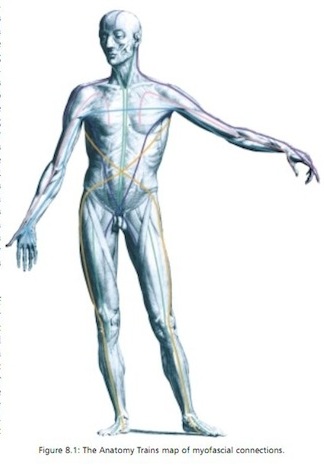Anatomy Trains
Holistic human anatomy
Anatomy Trains is a map of our musculoskeletal anatomy. It’s intended for hands-on and movement bodyworkers but is a great read for anyone interested in structure, whole-systems thinking, and brilliant design. I realized after doing Pilates for a while that I had no idea about anatomical structure and why Pilates was effective. While advocating no particular body/mind discipline, Anatomy Trains allowed me to understand why Pilates works. That was eight years ago; my understanding continues to expand over time.
Author Tom Myers asks a grand question: what would happen if we take a different cut at understanding the muscles and tendons? Instead of cutting against the grain at the ends, what happens when you follow the grain past the individual muscles and tendons and see how long the lines of tension go? Tom creates a set of rules and then starts mapping.
An anatomy expert could research and apply those rules themselves; I just followed along. The results are pretty cool: a map of about a dozen or so long lines of tension in our bodies. Most of them are longer than we are tall; some are almost twice as long. Some lines are roughly linear and some spiral around our torso and leg bones. Some lines are near the skin while some are next to the bones. Tom created a new term for these lines: myofascial meridians. Nobody has ever done this before, but the lines are real: Myers has gone into the lab multiple times with teams of students to dissect these long lines of tension in cadavers.
Myers studied under two remarkable body/mind instructors: Moshe Feldenkrais and Ida Rolf. He also studied under Buckminster Fuller, the great whole-systems engineer of the 20th century. The first chapter of the book, The World According to Fascia, provides a lot of background information for the mappings in the remainder of the book. Myers notes that there are three fractal/pervasive networks in our body: circulatory/chemical, nervous/electrical, and structural/spatial. He notes the elusiveness of the structural network: while we’ve had clear models of the first two for hundreds of years, our fine-grained structural network is still quite elusive. This is whole-systems thinking at its finest: lots of ideas how natural tech connects from the nano-scale to full-size human beings.
Like the great science book Godel, Escher, Bach: An Eternal Golden Braid, this book can be read at many different levels. The first way is just to look at the maps and the supporting drawings and charts. A second way is to read the various side discussions and notes. A third way is to plough straight through the rather dense text. I’ve never read AT from cover to cover, but I’ve gone through most of it and read almost all of the side discussions.
My one criticism of the book: its full title, Anatomy Trains: Myofascial Meridians for Manual and Movement Therapists, is enough to scare off those not in the industry. It is a wonderful and friendly book, but books like this must have a formidable title to be sold to medical/health professionals. The ideas it discusses are right on the edge of our understanding of biological systems, but there is not a milligram of woo-woo.
12/7/10Excerpt

*
Humans are not assembled out of parts like a car or a computer. "Body as machine' is a useful metaphor, but like any poetic trope, it does not tell the whole story. In our modern perception of human movement anatomy, however, we are in danger of making this metaphor into the be all and end all. In actual fact, our bodies are conceived as a whole, and grow, live, and die as a whole- but our mind is a knife.
*

Tensegrity structures, when stressed, tend to distribute rather than concentrate strain. The body does the same with the result that local injuries soon become global strain patterns.
(For those interested, here is a link to a 20-page read-only PDF that provides an overview of much of what is included in the book.--OH — editors)
Anatomy Trains Second edition Thomas W. Myers 2008, 440 pages $56






